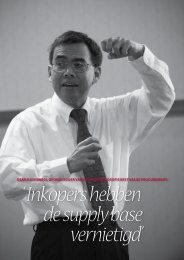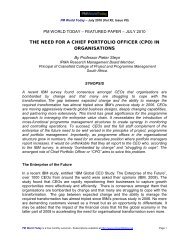Information Measurement Theory (IMT) - Performance Based ...
Information Measurement Theory (IMT) - Performance Based ...
Information Measurement Theory (IMT) - Performance Based ...
You also want an ePaper? Increase the reach of your titles
YUMPU automatically turns print PDFs into web optimized ePapers that Google loves.
CHAPTER 2: INFORMATION MEASUREMENT THEORY (<strong>IMT</strong>)<br />
which case the person would be a different individual and the event would be<br />
different).<br />
Theorem 29: A person faces a decision when he or she does not perceive all<br />
information. The individual must then make a decision on which “expected” outcome<br />
he or she thinks is the best choice.<br />
Theorem 30: If all of the information exists and someone perceives all of it, the person<br />
does not need to make any decisions because the outcome cannot be changed.<br />
Theorem 31: There is no “chance” or unpredictable event.<br />
Theorem 32: There is no randomness. Randomness, probability and statistics are used<br />
to understand what is currently happening in the absence of complete information.<br />
Theorem 33: The cycle of change requires the perception of information, the<br />
processing of the information, and the application of the information. By nature, it is a<br />
cyclical process.<br />
Theorem 34: The rate of change increases as the individual or entity repeats successive<br />
cycles of change, learns more information, and is able to process and apply the<br />
information quicker. A greater rate of change requires a greater level of perception.<br />
Theorem 35: A person‟s rate of change correlates to his or her ability to perceive,<br />
process, and apply new information. The “more intelligent” person changes at a faster<br />
rate and is able to more consistently predict the outcome of events. The “less<br />
intelligent” person changes at a slower rate.<br />
Theorem 36: Individuals who change at a very slow rate are “less perceptive,” have<br />
more difficulty identifying differences, and feel very uncomfortable with a changing<br />
environment.<br />
Theorem 37: All individuals have a change rate. No individual stays the same, even if<br />
the person‟s change rate is very slow. It is impossible not to accumulate information<br />
over time.<br />
Theorem 38: All individuals are changing in a positive direction. All individuals are<br />
improving their perception of more information.<br />
Theorem 39: All individuals are constrained by their capability to perceive and can only<br />
change at a predictable rate.<br />
Theorem 40: An individual is fully responsible and has full control over his or her own<br />
actions, decisions, and future environment. This will be discussed more in the next<br />
chapter on KSMs.<br />
© Dean Kashiwagi 2010 - 2 - 14





